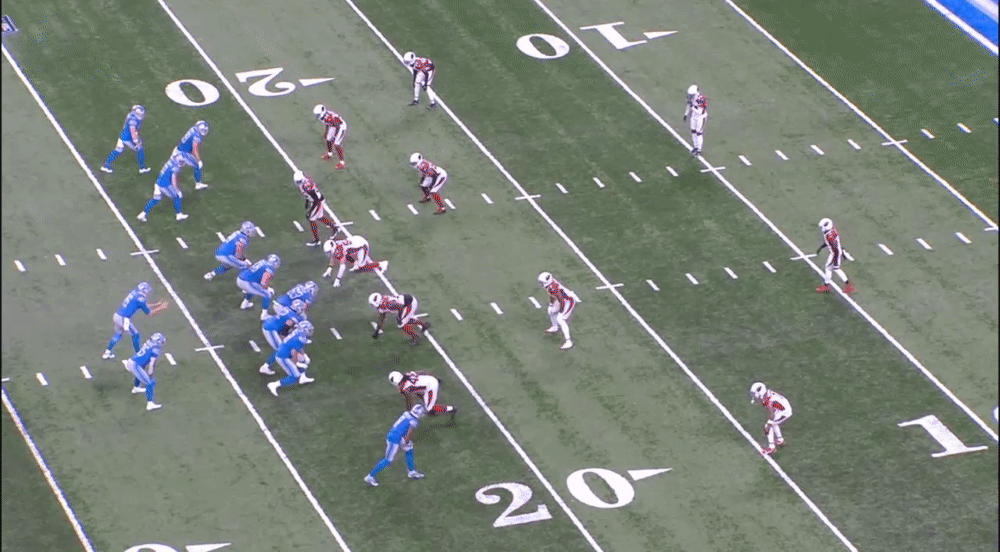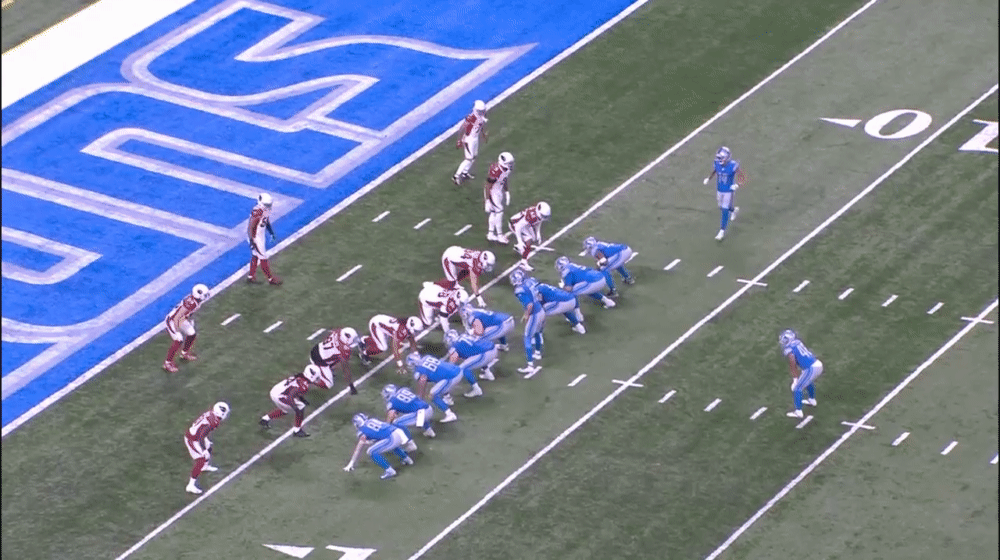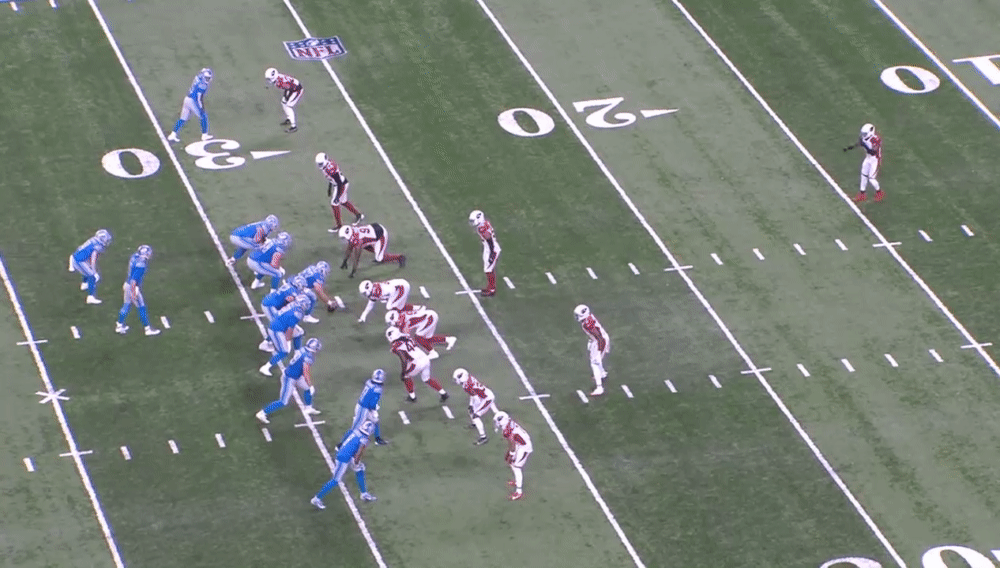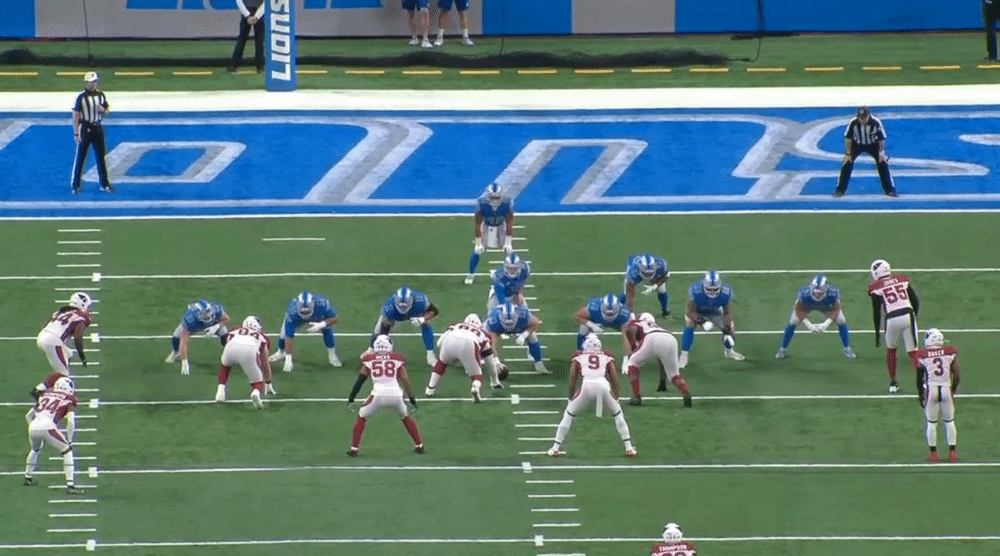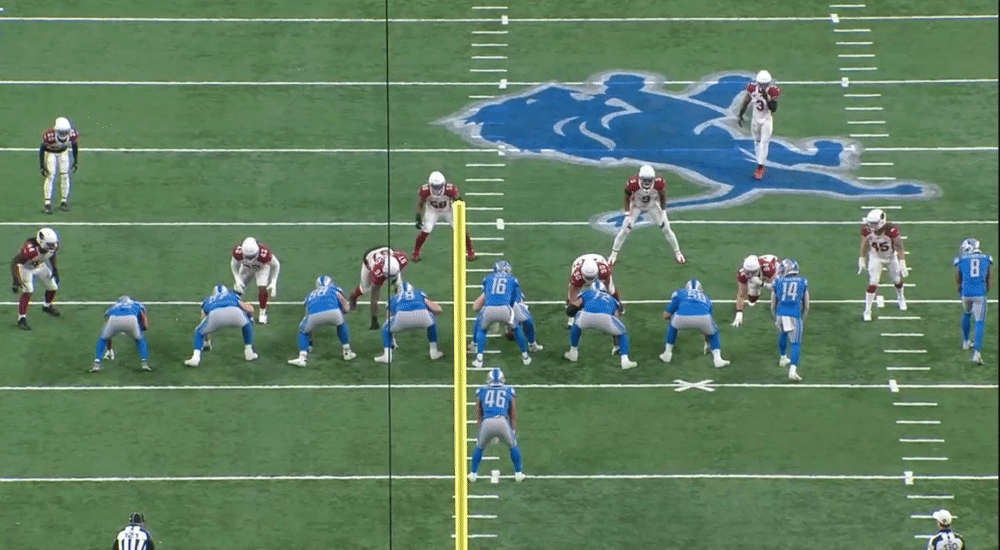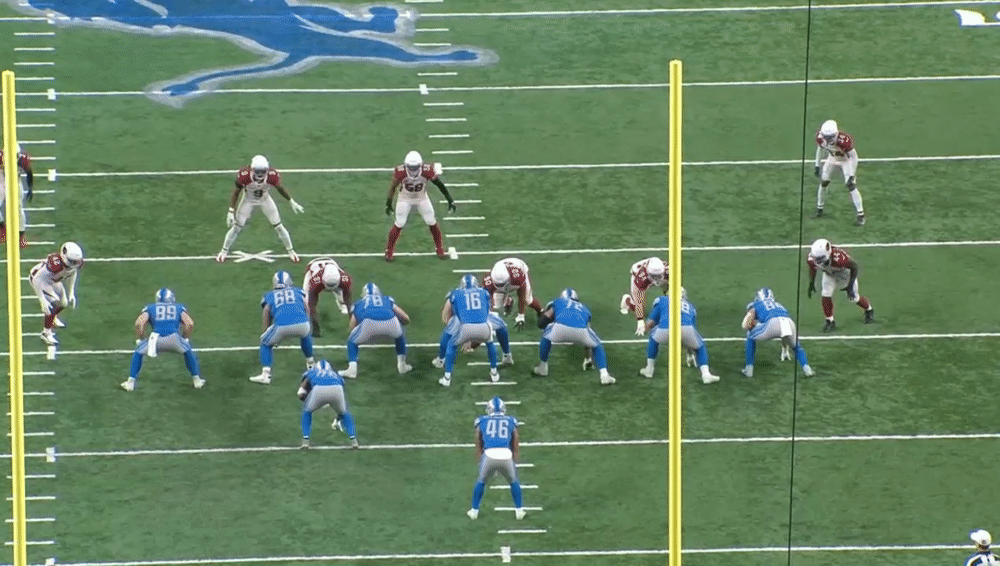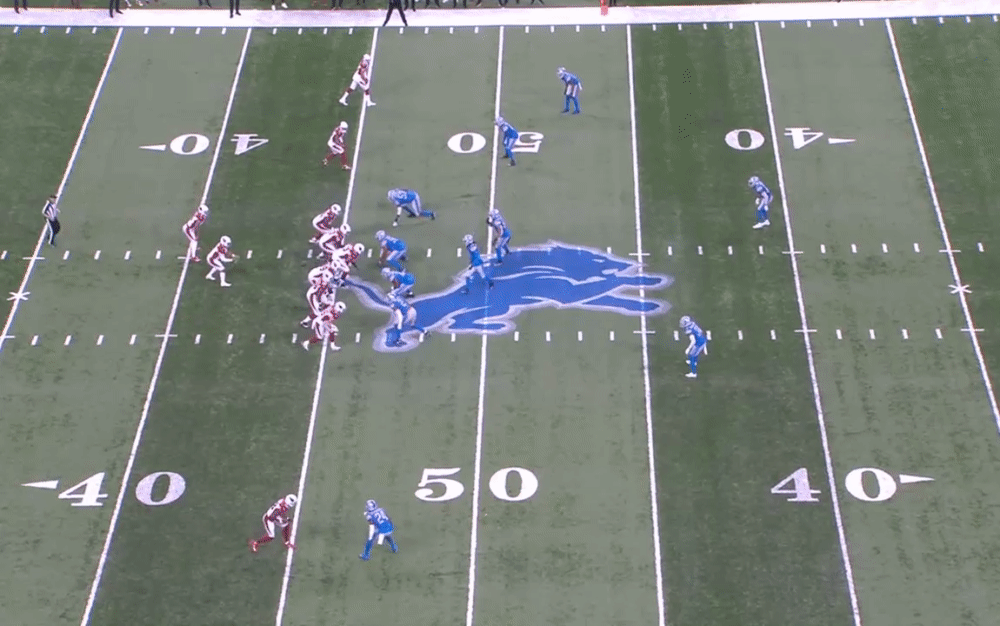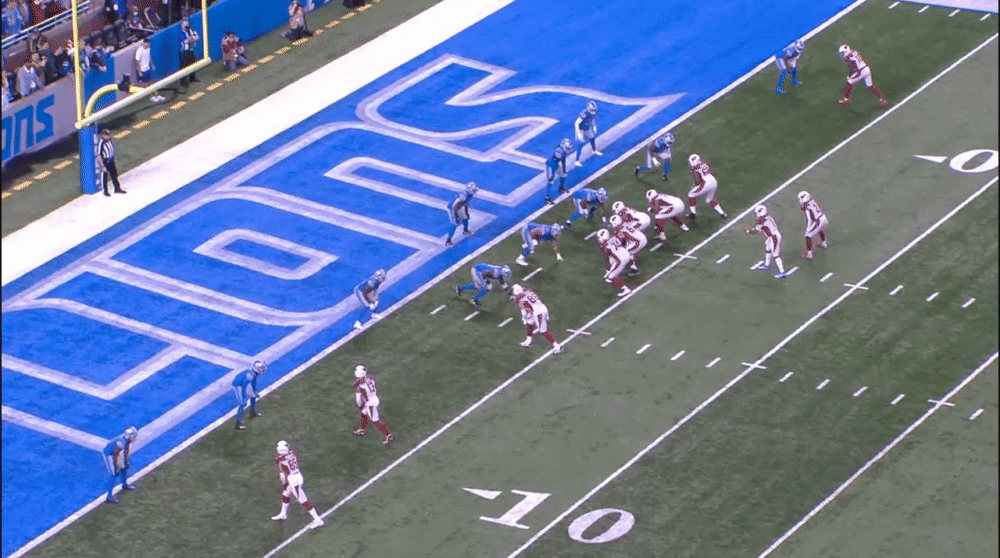Let’s be honest, the Detroit Lions’ dismantling of the Arizona Cardinals this past Sunday was wholly unexpected. Coming into the matchup as double-digit underdogs, the Lions got off to a hot start, overcame their mistakes and cruised to the easy victory.
Typically, we prefer to find a singular topic to refocus on after reviewing the film, but given the completeness of the performance, it seemed more appropriate to break down several aspects that contributed to the 30-12 win.
Touchdown tosses
It’s difficult to argue this wasn’t quarterback Jared Goff’s best performance in a Lions uniform. The veteran quarterback completed 21 of his 26 throws for 216 yards and three touchdowns. Outside of getting away with a highly interceptable pass across the middle on the first play of the second series, there aren’t many things to complain about from the tape.
Specifically, we wanted to focus on Goff’s three touchdown tosses.
The first, early in the second quarter, is a good example of a play working out despite some subpar execution.
Let’s start with the design. Despite having three receivers on the field, Detroit presented a run look with a condensed formation and a tight end motioning in off left tackle. The Cardinals countered with five defenders along the line of scrimmage, two more linebackers in the box and shallow split safeties, just 12 yards off the line of scrimmage.
The motioning of the tight end changed the defensive look, leading one safety to walk up ahead of the snap. As the ball was put in play, the Lions executed play-action, freezing the two linebackers and sucking that safety closer to the line of scrimmage.
The remaining three defensive backs in coverage committed to the vertical routes run by Detroit’s two outside receivers, with the deep safety providing over-the-top support on Josh Reynolds, running down the right seam.
Amon-Ra St. Brown, lined up in the right slot, initially blocked down on the edge rusher to that side, linebacker Isaiah Simmons, before breaking off on a shallow crossing route, leaving the defender to be picked up Brock Wright, the tight end pulling from left to right behind Detroit’s line.
Frankly, St. Brown didn’t sell the block particularly well, but combined with the play-action, it was enough for the defense to momentarily lose him. Five steps into his route, he turned upfield, angling toward the left sideline, an area vacated by the cornerback tracking Kalif Raymond going the opposite direction.
The play nearly collapsed when Wright missed his block on Simmons. Impressively, Goff not only recognized the free rusher, but was able to calmly step through the pressure and deliver the ball to St. Brown in-stride for the score.
The play was far from perfect, from St. Brown’s insincere block sell to Wright’s missed assignment, but had the receiver sold the block any longer, the timing of the play probably doesn’t work out. A happy coincidence, combined with excellent poise by the QB resulted in six.
Goff came back with a second scoring strike late in the first half, making another tough throw in the face of pressure.
With 19 seconds remaining, and the Lions at the 22-yard line, the offense lined up in a condensed formation, with three receivers left and Reynolds alone to the right, all inside the numbers.
The Cardinals showed a Cover-2 look with their safeties pre-snap, but morphed into a Cover-3 robber, bringing the safety to Goff’s right down to provide underneath support.
Reynolds ran a clean route, taking advantage of his inside leverage he drove into Murphy’s off coverage before breaking inside on a skinny post. That provided enough separation for Goff to deliver a ball over the robber.
The quarterback’s challenge was getting enough velocity on the throw while fading away. Goff had to drift backward in the pocket after guard Halapoulivaati Vaitai was beaten around the outside by defensive lineman Jordan Phillips.
With the defender bearing down, Goff wasn’t able to step through with the throw, causing it to flutter and be slightly behind preferred placement. It was enough that Murphy was able to have a shot at it, but Reynold secured it with two hands for the score.
Goff’s final touchdown came after Amani Oruwariye’s interception in the third quarter. On the first snap, the Lions ran a relatively simple, but well-executed clear out concept for fullback Jason Cabinda.
The Lions showed the Cardinals a clear intent to run on the first-and-goal snap from the 6-yard line, lining up with three tight ends, two off left tackle. St. Brown, the lone receiver in the formation, motioned inside from wide right, pre-snap, further selling the run.
As the ball was snapped, St. Brown ran interference, running directly into Murphy, the widest defender to that side. Cabinda, meanwhile, sold the play-action handoff by initially blocking before pealing off on a delayed route to the unoccupied left flat, easily beating Simmons, who had eyes in the backfield.
Versatile weapon
It was another big day for St. Brown, who recorded at least eight receptions for the third consecutive game, highlighted by the aforementioned touchdown.
But what was unique about his performance was how the Lions are increasingly using him out of the backfield.
St. Brown’s usage out of the backfield resulted in a 5-yard carry on a delayed handoff and two receptions, including a critical fourth-down conversion that set up Reynolds’ touchdown.
By handing it off to Brown on his first backfield snap, it kept the defense honest. But the ultimate ploy is the look creates a mismatch. We saw that on the fourth-down play, where the rookie receiver drew the coverage of linebacker Jordan Hicks.
In the shotgun formation, St. Brown lined up left of Goff, but immediately shot into the right flat, behind the perimeter blocking of Wright, Reynolds and Raymond. That blocking was critical to the play’s execution, but so was the mismatch as St. Brown was able to outflank Hicks to the edge and get the first down.
As the offense’s cupboard has been stripped of primary weapons due to injury and illness, you have to appreciate the creativity the Lions are utilizing to maximize the remaining options.
Hitting the century mark
It wasn’t too long ago the Lions had the longest drought in NFL history without a 100-yard rusher, so it’s easy to appreciate the fact fifth-string running back Craig Reynolds was able to hit the mark in his second game off the practice squad.
Volume was certainly a factor as Reynolds received 26 carries and didn’t eclipse 100 yards until his 22nd tote. And while Detroit’s blocking deserves some of the credit, Reynolds did a lot of the work on his own. According to Pro Football Focus, he forced six missed tackles and had a staggering 99 yards after first contact.
Let’s take a look back at Reynolds’ five longest runs against the Cardinals, which accounted for 69 yards, or 61.6% of his day’s total.
► 14:08, first quarter
An early example of Reynolds making something out of nothing came on his first touch of the day. Running out of an offset-I and a tight end attached to each tackle, the back was in trouble as soon as he took the handoff when Cardinals edge rusher Markus Golden charged into the backfield unblocked.
Impressively, Reynolds was able to avoid Golden 4 yards behind the line, bounce the carry outside, run through another tackle and gain 10 yards.
► 0:50, first quarter
Handing the ball off on third-and-five feels like conceding, but in this instance, it worked. Taking the shotgun handoff going left, Reynold raced around the edge, getting an inside seal from offensive tackle Taylor Decker, while center Evan Brown climbed to the second level and got a body on Simmons.
Even with Wright missing his assignment in the second level, those first two blocks were probably enough to get the first down, but Reynolds was able to beat safety Budda Baker to the edge and turn upfield, where the running back picked up some excellent downfield blocking from Raymond, netting 27 total yards.
► 13:26, second quarter
Reynolds showed impressive vision on the opening play of Detroit’s third drive after his run lane was abruptly filled by former Lion Devon Kennard, who shed the block of tight end Matt Nelson.
Reynolds downshifted, got low and compact and squeezed through a narrow lane in traffic to get outside the formation and turn what could have been no gain into an 8-yard pickup.
► 0:12, third quarter
Much like his first carry, Reynolds found himself in trouble in the backfield once again because of a blocking error. While it’s difficult to say who is at fault on the stretch-zone call, defensive tackle Leki Fotu got into the backfield in a hurry. That was compounded by Golden being left unblocked, by design, on the backside.
Somehow, Reynolds was able to spin out of Fotu’s grasp, simultaneously causing Golden to overrun the play. With the backside lane suddenly clear, Reynolds took the right edge and gained another 10.
► 10:51, fourth quarter
Looking to salt away the victory, Reynolds went over 100 with a 16-yard gain early in the fourth quarter. The blocking on the play was excellent, with Brown sealing inside of the left-side A gap and rookie Tommy Kraemer, working in tandem with Decker, sealing the outside.
The lane was further cleared after both linebackers in the second level tracked the pulling motion of Vaitai, who went wide around the left side. Only needing to beat the arm tackle attempt of the defensive tackle, Reynolds picked up his easiest yardage of the day.
Uncredited contributions
If you had to pick just one, the game’s key play was Oruwariye’s interception in the third quarter. It essentially nullified Detroit turning the ball over a few plays earlier and negated any opportunity for the Cardinals to build momentum for a comeback.
The interception was a thing of beauty — a diving effort, followed by the corner having the wherewithal to get up and return it 50 yards down to the 6-yard line, setting up Cabinda’s touchdown.
But what wasn’t fully appreciated on first watch was what happened on the opposite side of the field, which forced quarterback Kyler Murray to even attempt the throw Oruwariye’s direction.
You have to realize, many play designs are built on the backs of previous calls. And throughout the early stages of the game, the Cardinals had success with quick outs and bubble screens to the perimeter.
Arizona showed that look again, trying to catch Detroit cheating to secure a deep shot. On the snap, slot receiver Christian Kirk stepped back and threw his hands up, as if he was Murray’s intended target, while the wide man to that side, Antoine Wesley, shuffled his feet, as if he was going to block.
The Cardinals expected the Lions to drive on Kirk, allowing Wesley to release clean on a stutter-and-go deep route. But Will Harris, playing his first game at outside cornerback, showed impressive discipline on Wesley’s route, while picking up over-the-top support from safety C.J. Moore. That took away the throw.
Having to adjust, Murray missed tight end Zach Ertz on a right-to-left crossing route that would have extended the drive. Instead, the quarterback swung his gaze to the opposite side of the field and tried to fire to A.J. Green, running somewhat lackadaisically back toward the far sideline.
Yes, Oruwariye made the play, but we have to credit Harris for creating the opportunity for his teammate.
Clipped wings
As noted, Murray made two mistakes on the interception, first missing an easy read, followed by putting the ball in danger. It was hardly the MVP contender’s only mistake.
Murray misfired on no less than four throws, including a potential touchdown in the fourth quarter. In addition to the quarterback’s error, his receivers dropped three passes and there was a communication error in the red zone that led to a botched snap. That forced the Cardinals to settle for a field goal.
If Arizona executes the fundamentals, Detroit probably still wins the game, but not running away.
Because of this self-inflicted mishaps, defensive coordinator Aaron Glenn will have plenty of corrections to make from the film. That said, he’ll undoubtedly be happy with several individual efforts he received in contest.
Of all the plays I could point out highlighting the defense’s successes, the one I chose is a simple one demonstrating in-season growth.
Remember all the communication errors the Lions had in the secondary earlier this year? Well, many centered around nickel AJ Parker. But in his first game back from injury, the rookie properly executed an assignment switch on a fourth-and-goal, getting the pass breakup on the pick play and giving the ball back to the offense.
jdrogers@detroitnews.com
Twitter: @Justin_Rogers

